The Quehanna Wild Area in the Pennsylvania Wilds is one of the most remote corners of Pennsylvania. This 50,000-acre area spans parts of Elk, Cameron, and Clearfield Counties is little visited but features many fascinating spots worth seeing if you know where to look.
Previously, I’ve hiked through the Marion Brooks Natural Area (one of my favorite hikes in Pennsylvania) and visited the elusive Table Falls, Wykoff Run Falls, and Kunes Camp.
On a recent trip to the Quehanna Wild Area, I had a chance to check out one of the most unusual spots in Pennsylvania: the abandoned nuclear jet bunkers.

The land that would become the Quehanna Wild Area was bought by the state to protect it after the logging industry moved out of the area. The Civilian Conservation Corps made some improvements to the area in the 1930s, creating some of the infrastructure that you see in the area today.
In the 1950s, the Curtiss-Wright Corporation was looking for a large area of land to test nuclear-powered jet engines. This was part of an attempt by the U.S. government to discover other uses for the newly discovered nuclear power as part of President Eisenhower’s “Atoms for Peace” program.
Curtiss-Wright purchased 80-square miles of land in 1955 to build a nuclear testing facility. The land they purchased was set up as a 16-sided polygon, as that would prove easier to entirely fence in than a circular parcel of land. All told, they required a fence 24-miles in length to encircle the property.

The jet bunkers were placed in the center of this polygon. The reason was if the engines were ever to break free, they wouldn’t be able to travel outside the fenced area.
It was Curtiss-Wright that gave the area the name “Quehanna”, which they named after the West Branch of the Susquehanna River.
In addition to the jet bunkers, Curtiss-Wright also built a nuclear reactor in the area, as well as a foam factory.
The nuclear engine program was discontinued by the government in 1960, quickly ending much of the work that went on in the area, including the factory and ownership of the nuclear reactor. By 1967, the state had purchased the land back and created what was then known as the Quehanna Wilderness Area.
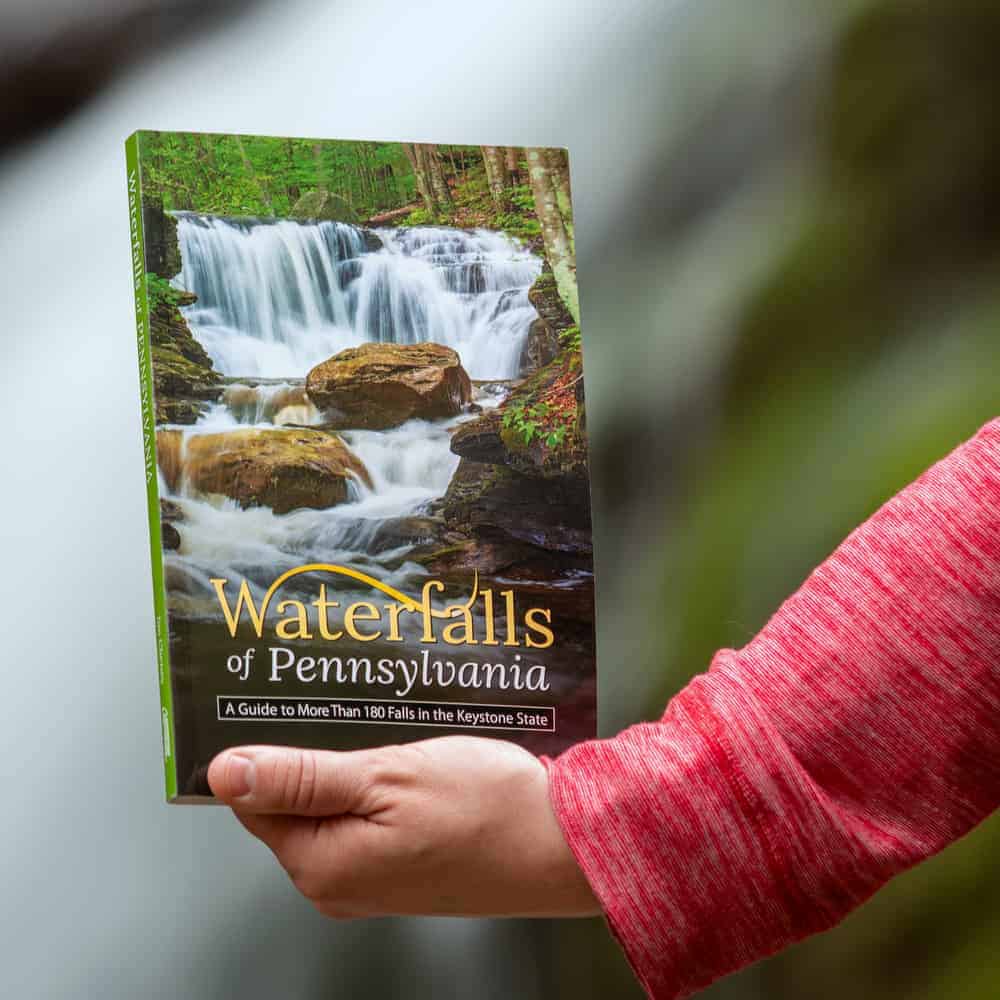
"Waterfalls of Pennsylvania" by Jim Cheney
If you love PA waterfalls, you won't want to miss this waterfall book from Jim Cheney, author of Uncovering PA, featuring more than 180 great waterfalls. Order it now on Bookshop.org or Amazon.
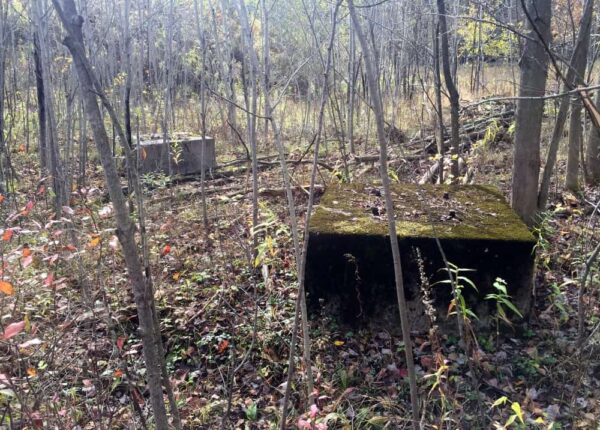
Today, the nuclear reactor has been dismantled and the old factory is used as both a minimum security prison and a heavy equipment training school.
The jet engine bunkers, however, are still out there and hidden away in the woods of the Quehanna Wild Area.
While the two bunkers are relatively close to each other, they require two separate hikes to reach.
For the first one, an old roadway leads off from a small parking lot at the intersection of Quehanna Highway and Wykoff Run Road. After hiking along this overgrown old roadway for about half a mile, it disappears into an overgrown field.
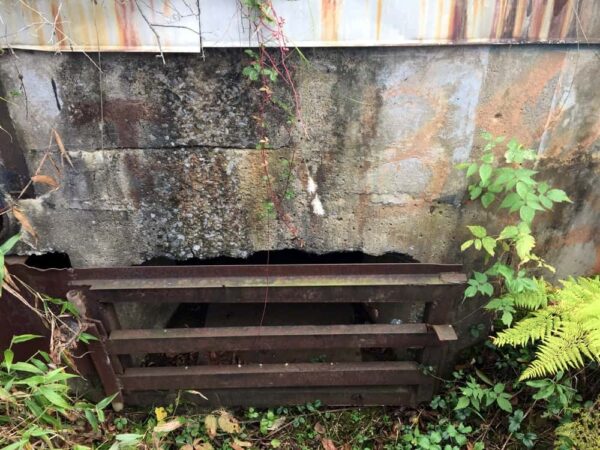
Remnants of the site’s industrial past can be found scattered through this field, and it’s interesting walking around to see what can be found.
At the center of the field is a small hill. This is the site of the buried bunker.
To be honest, there isn’t a whole lot to see here. There are a few small windows (or possibly vent holes) that can be peered into, but not much can be seen inside the bunkers themselves. Currently, it is considered a bat habitat, which is a great way to reuse an underground bunker.

The second bunker site can be accessed via a closed roadway off of the Quehanna Highway. A half-mile walk along this flat path brings you to this neat area.
There is a bit more to see here, primarily because there is a small, black building that is still standing in the middle of the site.
While the building is closed to the public, it’s still neat to walk around it and look around the site. Here, you’ll find discarded items, a retaining pool, and a large concrete pad.

While there isn’t a ton left to see at the abandoned nuclear jet bunkers sites, what makes these spots cool is the chance to legally visit an abandoned place in Pennsylvania that has connections to both the US military and our nuclear past. It’s also fascinating to see how nature has begun to reclaim sites that were so heavily damaged, first by logging and then by nuclear testing.
So, if you’re looking for something interesting to do in the Quehanna Wild Area, don’t miss the abandoned jet engine bunkers.
How to Get to the Abandoned Jet Bunkers in the Quehanna Wild Area
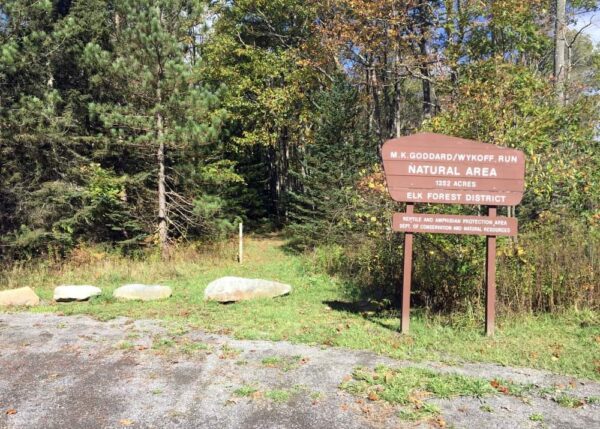
The nuclear jet engine bunkers sit in the middle of the Quehanna Wild Area in Cameron County, Pennsylvania.
While there are a few ways to reach the first site, the best is to park in a small dirt lot at the intersection of the Quehanna Highway and Wykoff Run Road. The parking area can be found at the following coordinates: 41.229955, -78.192041.
From here, a trail leads off into the woods. This trail is wide and easy to follow as it was once a road, though it’s quite overgrown and had a few blowdowns along it when I visited.
Follow this trail for about half a mile until you come to an obvious clearing at the following coordinates: 41.237006, -78.195818.
The remnants of the jet bunkers can be found in this clearing.
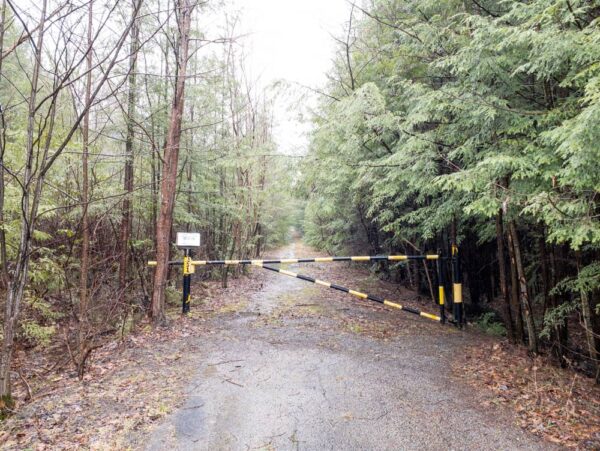
The second nuclear jet bunker site can be accessed via a gated road off of Quehanna Highway at the following coordinates: 41.237093, -78.203533.
From this parking area, walk down the gated road for half a mile until it ends at a large clearing.
Remember that this is an abandoned nuclear site, and while no warnings exist, you are visiting at your own risk. While all access areas to the bunkers are closed to the best of my knowledge, do not enter this underground lair should you find an opening.
Looking for more to do in the area? Check out the Elk Country Visitor Center, Round Island Run Falls, and The Little Museum of Cameron County.






 "
"




very interesting!!!!
I visited these two bunkers in the early 1960’s and for many years thereafter. In earlier years they were still able to be entered through a doorway and once inside the bunker you could look out through the really thick glass block windows and see the steel frame where the engines were mounted to and then controlled from inside the bunkers. There was still some controls that remained at that time. Directly on the outside of the thick glass block window was where the jet engine was mounted to a steel frame, which held the engine at a slight downward angle. The frame was mounted in concrete and the whole area directly below the engine was covered in concrete. The concrete then continued slightly downhill until it reached a small man made pond that was used to capture the hot exhaust gases coming off the jet engines. It was not until many years later that I found out that the real purpose of these experiments was all about trying to make the jet engines run on nuclear power.
I have visited this area a hundred times over the past 65 years. As a very young child we visited the entrance to the Quehanna Area above Karthus and the fences were there and so so were the armed military gards that walk the fence line. My father purchased a hunting camp above Pottersdale. We have maintained this camp and have passed the “joy” of visiting the remote areas of PA to my son. He has a son on the way and can’t wait to do the same to his son. Thank you for your article.
Yes, this is very interesting, I’m sure many of us native Pennsylvanians have never heard of a lot of these places.
We went today and used your info! We couldn’t find the big black building, but the bunker which is covered has now been opened. We didn’t go in, but it appears some have!
My father worked there, i have been in the bunkers 100’s of times, he showed the sites where they buried waste, i was there when they tore out the spring on the road to blackwell damn. As a teenager i spent countless hours in the reactor building, up on the control platform, played inside the lead decontamination room, played with the robotic arms used to mix the radio isotopes. My very close friends father ran the plant, was a close personal friend to the man second in charge. I remember going to the plant on sat morn with Dr. _ _ _ _ , grabbing radiation badges we had to wear to monitor the radiation we wete exposed to, tnen running back and peering into the pool that contain the nuclear cells……i couldnt even imagine that happening today. I also have 8mm movies taken by my father of jet engines running on the stands…very cool
Thanks for these awesome memories & added insights! It would be wonderful if you were someday able to transfer those 8mm movies to Youtube videos (and post the link here of course:). Thanks again!
Hello Randy,
My father has had a cabin off of Quehanna Hwy (Ardel Road) since 1960.
I’m just recently learning of the Curtiss – Wright Reactor and Nuclear Jet Engine Bunkers.
My brother and I still visit often to ride motorcycles and hunt.
Any chance you could convert the 8mm film you have to a digital file that could be emailed?
I would love to see the footage you have of the engines running.
This article is a little misleading, in that these bunkets are not ” underground” my understanding is that they have been covered with dirt, back in the day when we used to frequent these bunkers they were above ground and you coukd go inside of them. Although they were considering using nuclear energy as a fuel for jet engines, the primary tests carried out here was ,”duration testing”, in other words a nuclear powered jet, in theory could fly for years without refueling so they wanted to see how long a jet engine could run. My father told me they woukd put engines on the stands, turn them up and let them run unril they came apart. As far as i know no nuclear fuel was ever used to actually power an engine. Later at one of the test sites in 66 i believe, two men were killed in an explosion rumored to be nuclear, it was not, it was caused by the two men working on one of the fuel tanks when he accidently cut through the tank with a torch. I remember my father telling me that they found the door of the glove compartment of the mens pickup truck over a mile from the site if the explosion, and my uncle, who also worked there saying it rattled his windows in his home in Karthaus.
On a side note, the town of Pine Glen appeared virtually overnight, all the homes you see when you pass through the town on 879 were built by the govt, including the ” units” as they wete called, which are the homes that look like a + sign, each containing 4 homes, each with a large one car garage, large livingroom with a fireplace, and two bedrooms. Although i never really ask, i assume the single family homes were for upper management people. These homes at the time of their construction wete state of the art homes, with the most modern appliances including the oven which was built into the wall, something i had never seen in 1969 when i first was in one of these. All in all pretty interesting stuff.
Later when Curtiss Wright moved out the reactor was then used to produce ” permagrain” wood flooring, it was solid wood parkay flooring, the wood was loaded into long steel ” cans” and tjen loweted in the pool containing the colbalt nuclear cells whete it was ” cooked ” for around 20 hours then removed. After this process the wood became nearly indestructible, you coukd not even drive a nail into it, this ” imoregnated” wood flooring was extremely durable and just as beautiful and nearly every home in Pine Glen has some amount of flooring inside. They also imoregnated some handles for Case knives and some stocks and forearms for some winchester shotguns, in fact my father’s winchester Model 1400 has one of these impregnated forearms. I am very lucky to have known so many people who wete invilved with the goungs on thete from Curtisd Wright through PermaGrain, also know as Arco Radiation and Process Center, the name thevreactor building had before becoming Perma Grain.
I have a PSu Football Program that contains a full page ad, ℭ𝔬𝔪𝔭𝔩𝔢𝔱𝔢 with a graphic showing rockets and missiles being fired out of center County,, that was enticing students in physics, nuclear engineering, chemical engineering etc to take b jobs up in the 80 square mile “ reasesrch park. The new community built for scientists by the government had some functionality as late as 1972 . My neighbor in State College, a PHD candidate had a fellowship to work with students there. That is when I first heard about Quehanna
Wow so very interesting l would love to visit these places but with two hip replacements and a bad knee unfortunately I cant walk that far oh well at least I can read about all the great facts so thanks for sharing all these great stories
Dude, that is just to cool! Do you know for certain that the bunkers are bat habitats? Would love to go inside them, just sucks they are now closed to the public. You have the best site, & the greatest expansions, keep up the great work!
They are not closed to the public as far as I know. I’ve been there before. The one that’s “underground” was just covered with a dirt mound and the other one was above ground and yes there are bats that are most likely protected, so maybe they did close them. It’s been years since I took a trip to the echo chambers.
I used to visit the bunker sites when I worked for the Bureau of Forestry in the late 70’s.
There was a large cleared runway near Hoover road that I assume was to bring equipment and personnel to the site.
There are many dump sites that may still emit radioactivity in the area.
The 2 men killed were foresters that were removing the stairs from the fuel tank. I believe one man was Fred Woods.
I believe there is a memorial plaque at the parking lot with the history of the explosion and the men who were killed.
Also, My brother in law worked at Permigrain as their electrician.
Like other people said, the flooring was indestructible.
I spent many teenage evenings here, do what ya did in the 80s, haha. I, too, had come across armed men after we went too far past a gate, as mentioned above. I haven’t been out in 35+ years but reading this and seeing the pics reminds me of much easier times. I do know, Penn State was acquired to clean up after the nuclear power plant days. Many stories of radiation disfigured animals, etc… I want to go back after reading this. God bless.
I visited these sites and can’t help but wonder what kind of radiation is still present. You’d think it’s safe considering how easy it is to access.
If anyone has access to test equipment it would serve the public to know exactly what we’re dealing with her.
I probably wouldn’t eat berries I found there, but I’m sure it’s perfectly safe for short-term visits. If it wasn’t, there would be signs everywhere.
great memortes…thank you for sharing
Sgt Pleak, USAF